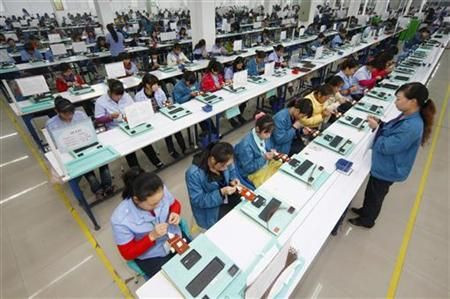China PMI in Surprise Fall to Lowest Point Since 2009

China's big manufacturers ran at their slowest pace in October since early 2009, purchasing managers' data shows, though signs of a bounce-back at smaller firms and a sharp fall in factory-gate prices suggest no swift change to interest rates.
China's official purchasing managers' index (PMI) fell to 50.4 in October from 51.2 in September, countering expectations for a rise. The National Bureau of Statistics blamed the drop on weak European and U.S. economies.
A private-sector PMI though set a different direction, rising in October to 51.0 from 49.9 in September, the index's first rise above 50 that demarcates contraction from expansion since June.
Taken together, the PMIs backed the consensus view that Chinese interest rates will remain on hold as Beijing balances a need to tackle inflation with concerns that growth is slowing down.
Instead, more fine-tuning via a policy of so-called selective easing to help specific sectors of industry may be in the pipeline.
All these signs may give Beijing good reason to adopt kind of selective easing in the monetary policy in the coming months, Tang Jianwei, an economist at Bank of Communications in Shanghai, said.
We expect the central bank may opt for net injection in the money market operations and may loosen some bank loan curbs in the months ahead. There is also a chance of cutting the reserve requirement ratio for banks in the fourth quarter, Tang said.
It's not unusual for the two indexes to deliver divergent results.
China's official PMI, compiled by the China Federation of Logistics and Purchasing (CFLP) for the National Bureau of Statistics, gathers more data from the country's biggest manufacturers.
The private-sector gauge, compiled by UK-based private-sector data specialist Markit in conjunction with HSBC, focuses on the small and medium-sized enterprises that provide around 75 percent of the jobs in China.
Still, the drop in the official PMI to its lowest level since February 2009 rattled the Australian dollar, which fell almost half a cent against the U.S. dollar immediately after the index was released. It also added to bearish sentiment in stock markets.
The fall of PMI in October points to further economic slowdown in the future, Zhang Liqun, a researcher with the Development Research Center of the State Council, wrote in the CFLP statement.
That suggests Chinese policymakers will continue on the fine line between battling inflation and supporting growth, particularly in small and medium-sized businesses.
Premier Wen Jiabao has maintained tackling inflation is a priority, but in a nod to slowing growth has also said Beijing will fine-tune policy if need be. [ID:nL3E7LP29A]
Indeed, Beijing has already announced measures to support small firms and has intervened in the stock market to prop up banks.
Zhang Zhiwei, chief China economist at Nomura Securities, said the official PMI was not as alarming as it may seem, so there was no need for the central bank to relax macro monetary policies.
Given the drop of the PMI is mostly driven by seasonality rather than economic weakness, we maintain our view that reserve ratio requirements and interest rates will remain unchanged for the rest of 2011, Zhang wrote in a note to clients.
He said that October's decline in the index of 0.8 point was broadly in line with the historical average decline of 0.9 point, which offsets the fall in the new orders and production components of the official PMI.
EXPORT ORDERS DROP
The official PMI recorded falls across key component parts with new orders, which make up 30 percent of the index, slipping to 50.5 from 51.3 and production -- another 25 percent of the headline number -- easing to 52.3 from 52.7.
New export orders dropped to 48.6 from 50.9.
A moderate rebound in China's PMI in recent months had held out hope that the country's vast factory sector was bottoming out after a soft patch earlier this year, when world demand waned on debt problems in the United States and Europe.
But with Europe -- China's largest export market -- still struggling to resolve its debt problems, many investors believe the Chinese economy faces more gloom than cheer right now.
Still, a fall in the input price sub-index to below 50 for the first time since April 2009 showed that inflationary pressure in the manufacturing sector has eased and price rises have been brought under initial control, the NBS said.
Input prices showed a sharp 10.4 point fall in the prices sub-index of the PMI to 46.2.
China began tightening monetary policy in October 2010 in a fight to bring down inflation.
Economists say it appears to be working as the consumer price index has eased from a near three-year peak of 6.5 percent in July.
The market consensus is for full-year inflation of 5.5 percent, above the government's official 4 percent target, a Reuters poll shows.
The CFLP said in its statement that it expected China's economy to grow 9.2 percent in 2011. That would imply a further easing of activity in the last quarter of the year after growth slowed in the past three quarters.
(Additional reporting by Aileen Wang; Editing by Ken Wills and Neil Fullick)
© Copyright Thomson Reuters 2024. All rights reserved.


















